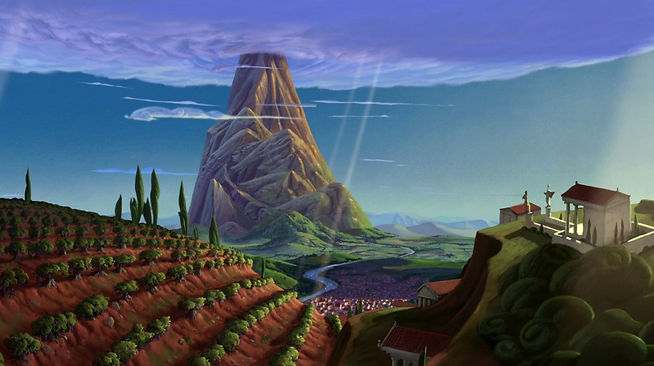
Hooray for Hercules!
The Set
Hercules does a great job at establishing the setting as taking place in Greece, not Rome. This is done through the mise en scène design, which incorporates iconically Greek visuals. In wide shots of the Greek countryside, the great presence of Mount Olympus as it ascends upward toward clouds is a nod to Greek mythology that audiences are generally already familiar with. In addition, the natural landscape is filled with Cypress and Greek Juniper trees. Though less recognizable by most people, the accuracy of using native Greek plants is appreciated and helps the setting make the distinction of being Greek, not Roman.

The art and architecture in Hercules also helps to point viewers in a Greek direction. Throughout the movie there is a motif of the meandros design pattern, which is commonly used in Greek art. The meandros is seen on pottery, in floor tiles, and in stone columns in Hercules. In modern depictions of Greek culture, the meandros has become a standard form of Greek representation. It also hasn’t typically been used in the toga movies we’ve seen that are set in Rome and made prior to Hercules, which helps the audience distinguish between the two locations. The recurring imagery of pottery and the unique designs on each pottery piece are also very Greek. Designs range from telling the Greek mythological narrative of Heracles and his 12 tasks to showing other Greek symbols like the laurel wreath. The pottery in the movie closely resembles historical pottery artifacts from ancient Greece, which adds some authenticity to such generalized tropes pertaining to Greek designs included in Hercules.



The majority of the architecture presented in the film is of Greek temples and stone buildings. When one thinks of Greek architecture, one naturally imagines big white columns. Hercules certainly delivers in providing such visuals. The ancient Greeks typically adhered to three major column styles: Doric, Ionic, and Corinthian. The columns in Hercules, however, adhere to the Doric and Ionic variations, and this attention to detail of upholding a sense of historical accuracy for something seemingly unimportant doesn’t go unnoticed.


The value of creating set designs based on audience expectations and stereotypes of Greek culture is discernibility that the setting is Greece, not Rome, which helps connect Disney’s take on Greek mythology to its historical roots. The anachronisms that come from such stereotypes, however, cannot go unignored. The constant 90s pop culture references are not accurate to Greek culture, and make the Greek city of Thebes (which Phil calls “The Big Olive”) in Hercules feel like a stand-in for the American city of New York (known as the “Big Apple”). For example, the character Hercules reaches celebrity status and produces merch like Air-Hercs (similar to Nike Air Force shoes), puts his hands in cement like it's the Hollywood walk of fame, and his mentor Phil references the line “I’m Walking Here” (from the 1969 movie Midnight Cowboy) which is a saying closely associated with New York City life. Hercules also makes the mistake of referencing Roman culture and attributes, namely with the line “Somebody call IX-II!,” which are Roman numerals, not Greek. Despite these modern and Roman insertions within an ancient Greek culture, the setting of Hercules overall successfully accomplishes feeling like it takes place in Greece.





